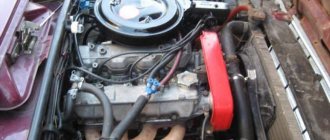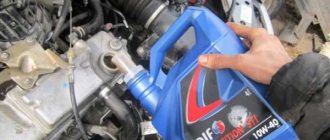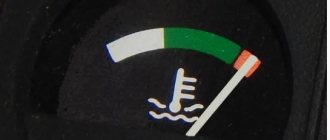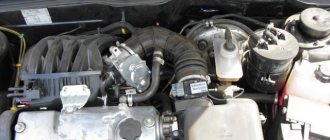Disassembling the VAZ 2101 to 2107 engine
The overhaul of VAZ 2101 to 2107 engines is the same, there is only a difference in the size of the pistons and the size of the crankshaft. For example, the VAZ 2101 engine and the 21011 engine differ only in the pistons; on the 01 engine the pistons are 76mm in size and on the 011 they are 79mm, and everything else is the same.
Also, the 2103 engine has 76mm pistons. and 2106 79mm. and everything else is the same. Also, the difference between the 2101 and 2103 engines is only in the crankshaft, chain size, 2101 and 21011 have 114 links in chain length, and in 2103 and 2106 have 116 links, and in the length of the distributor rod, and everything else is the same.
Therefore, when repairing an engine, you just need to know the engine model.
I will give you complete instructions for overhauling the engine yourself, at home.
I will be repairing engine 2106, it jammed because the owner of the six was driving without oil pressure.
On this page of the site I will explain how to disassemble the engine and determine the repair method
Since the engine has been removed, without the head, we can say that half the work is already done, all that remains is to disassemble it, at home it is easier to disassemble it on an old tire, first we begin to remove the pan.
Photo. Engine with pan removed.
Pay attention to the photo, the 2nd and 3rd connecting rods are blue and dry, then remove the oil pump and start unscrewing the connecting rods, but be sure to immediately pull it out after unscrewing the connecting rod, put a cushion on it and attach it, the cushions cannot be changed, each connecting rod has its own cushion .
Photo. You can see the torn splines in the oil pump drive gear.
Once the connecting rod and piston are removed, you can immediately determine the wear of the piston engine (the piston with the connecting rod is pushed up the engine), looking at this piston, you can see that gases have broken through the rings, this is indicated by carbon deposits on the piston skirt. Also, when you run your finger along the cylinder, you feel a small step at top dead center, this indicates that there is wear in the cylinder.
Photo. Piston with connecting rod.
I measure the piston, it is 79mm. This means that this engine has never been bored, and there is room for two more borings. I decide to bore the block for the first repair, these are 79.4mm pistons.
Photo. Jammed liner.
I unscrewed the liner from the jammed connecting rod, and here I need to decide whether to replace the connecting rod with a new one or leave this one. Not everything is so simple here, of course, if you have extra money, you can immediately buy a new connecting rod and adjust it to the weight of other connecting rods. But I have been working on engines for a long time and have seen all sorts of breakdowns, the most important thing in the connecting rod is that the liner in the connecting rod bed does not turn and the piston pin sits very tightly, and the fact that it turns blue from heating is not scary. So the owner of this six was lucky, the liner in the connecting rod did not turn, so I leave these connecting rods, which of course affects the price of spare parts.
Photo. Intermediate shaft sprocket.
After removing the connecting rods, unscrew the intermediate shaft sprocket and remove the chain.
Then unscrew the clutch basket and the flywheel itself, to make it easier to unscrew the flywheel, put a piece of wood or a large key in the crankshaft so that the crankshaft does not turn when unscrewing the flywheel.
Next, untwist the crankshaft cushions, but be sure to remember which cushion is in which place; cushions cannot be swapped. Remove the crankshaft and unscrew the engine mounting ears; they will interfere with the block boring. Usually I don’t unscrew the pump; if everything is fine with it, then there is no point in removing it and wasting time.
Photo. Engine block and crankshaft.
Now we need to make a list of spare parts that will need to be purchased to repair the engine, but it is very important that the pistons are purchased before the block is taken for boring, the boring machine bores the engine block for the pistons. And liners for the crankshaft are bought after boring, when it is known what size the boring machine was bored to. Since the crankshaft was standard, I predict that most likely after boring the liners will be 0.25, but the boring machine will tell you for sure.
It is also very important, be sure to ask that the block be bored to fit the mirror, and not in any case to fit the mesh.
When choosing pistons, I usually choose “Kharkov” or “AVTRAMAT”.
Boring a block for a mesh or mirror
No matter how I argue that boring a block under a mirror is better than boring it under a mesh, this will not seem convincing to many.
Therefore, I will try to explain so that you yourself understand the difference.
When a piston with piston rings rubs against the cylinder wall in the form of a mesh, the mesh consists of rough grinding with coarse sandpaper. The cylinder with the mesh turns out like a small file; of course, this file immediately begins to grind off the piston rings and the piston. In turn, the piston rings and piston grind down to smooth out the mesh in the cylinder, gradually filling the mirror. The result is that the piston and rings fill the mirror in the cylinder, but they themselves are already half worn out, plus there is a lot of wear in the cylinder itself. Engines made to fit a grid do not last long and begin to consume oil very quickly.
What engines were the first VAZs equipped with?
“Kopeykas” were equipped with two types of power units: 2101 and 21011. The design of the first was borrowed from the Italian Fiat-124. But this was not a copy, but a real improved version, although the camshaft was modernized. Unlike the Fiat, in which it was located at the bottom of the cylinder head, in the VAZ 2101 the shaft was located at the top. The working volume of this engine was 1.2 liters. It was capable of developing a power of 64 hp. s., which was plenty at that time.
The VAZ 2101 engine differed from its predecessor in volume, which increased to 1.3 liters, and, accordingly, in the size of the cylinders. This did not lead to a significant improvement in power characteristics, however, it was this unit that became the prototype for subsequent modifications, namely 2103 and 2105.
Table: main characteristics of VAZ 2101 and VAZ 21011 engines
| Positions | Indicators | |
| VAZ 2101 | VAZ 21011 | |
| Type of fuel | Gasoline A-76, AI-92 | Gasoline AI-93 |
| Injection device | Carburetor | |
| Cylinder block material | Cast iron | |
| Cylinder head material | Aluminium alloy | |
| Weight, kg | 114 | |
| Cylinder arrangement | Row | |
| Number of cylinders, pcs | 4 | |
| Piston diameter, mm | 76 | 79 |
| Amplitude of piston movement, mm | 66 | |
| Cylinder diameter, mm | 76 | 79 |
| Working volume, cm 3 | 1198 | 1294 |
| Maximum power, l. With. | 64 | 69 |
| Torque, Nm | 87,3 | 94 |
| Compression ratio | 8,5 | 8,8 |
| Mixed fuel consumption, l | 9,2 | 9,5 |
| Declared engine life, thousand km. | 200000 | 125000 |
| Practical resource, thousand km. | 500000 | 200000 |
| Camshaft | ||
| location | top | |
| valve timing width, 0 | 232 | |
| value of the exhaust valve advance angle, 0 | 42 | |
| intake valve retard, 0 | 40 | |
| diameter of seals, mm | 56 and 40 | |
| width of seals, mm | 7 | |
| Crankshaft | ||
| Neck diameter, mm | 50,795 | |
| Number of bearings, pcs | 5 | |
| Flywheel | ||
| outer diameter, mm | 277,5 | |
| bore diameter, mm | 256,795 | |
| number of ring teeth, pcs | 129 | |
| weight, g | 620 | |
| Recommended Engine Oil | 5W30, 15W40 | 5W30, 5W40, 10W40, 15W40 |
| Engine oil volume, l | 3,75 | |
| Recommended Coolant | Antifreeze | |
| Coolant quantity, l | 9,75 | |
| Timing drive | Chain, double row | |
| Cylinder operating order | 1–3-4–2 | |
Engine tuning 2101
Description of the VAZ 2101 engine tuning process
Tuning a penny engine, or as they also say, boosting the engine of a VAZ 2101, is a risky business, taking into account what is written above and taking into account the general wear and tear of the engine, if this does not stop, then let's go... first, let's look at it from the point of view of increasing the engine displacement. This is the most affordable method to improve your engine, increasing power and torque throughout the entire range. We will also describe the option of installing sports camshafts, boring cylinder head channels, compressors, etc. in detail below. But given the fact that your engine is a used 2101, hanging too much on it is fraught with consequences. To increase the power of the VAZ 2101 engine, let's start with cars produced in 1970-1974; they are distinguished by the ability to install Niva pistons with a diameter of 82 mm from the VAZ 21213 Niva, thanks to the thick-walled cylinder block. To prevent the compression ratio 2101 from sagging (a puddle in the pistons 21213), you need to take Niva pistons with a flat bottom or lighter pistons 2112 and cut off the displacer from the pistons. With a standard stroke of 66 mm, the engine volume will be 1.4 liters. We will get an increase in power, but the engine itself will be very high-speed. The increase in engine volume of the VAZ 2101 produced after 1974 is somewhat different; in order to save metal, the cylinder block became thin-walled, the maximum possible piston diameter is 79 mm from the VAZ 21011 or 2105. The piston stroke is increased to 80 mm. implemented by installing a crankshaft from a VAZ 2103 and connecting rods with a reduced center-to-center distance (129 instead of 136) or installing pistons with a reduced compression height, produced by TRT. Disadvantages of short connecting rods - the angle of inclination of the connecting rod, the greater the angle of inclination, the greater the force it presses the piston against the cylinder wall, the resistance to movement increases, lubrication conditions worsen, the cylinder walls wear out, the connecting rod works under greater load (especially in the center of the connecting rod), engine reliability 2101 is decreasing. Among the advantages, we note a good cylinder filling rate at medium and low speeds, a more homogeneous mixture, and improved combustion. The disadvantages of TRT pistons are their lower strength compared to standard VAZ 2101, thermal load on the ring and the likelihood of piston burnout. Increased piston stroke to 84 mm. VAZ 2130 crankshaft, as well as use TRT pistons, connecting rods shrink to 134 mm.
Boring of VAZ 2101 engine
The crankshaft and boring of the VAZ 2101 engine will give you the following volumes: - larger diameter piston, standard stroke 1.3 liters. 79x66 (cylinder diameter X piston stroke)
64 hp Maximum torque is about 95 Nm at 3400 rpm We get an analogue of the 21011 engine - a larger diameter piston, a standard stroke of 1.4 liters. 82x66 (until 1974) Such VAZ engines were not produced in series; there is little information about the construction of such engines. This is explained by the fact that in order to adequately use such a motor, you need a reinforced bottom, forged pistons, selecting the desired top shaft, etc., plus everything needs to be properly configured. The maximum speed of the correct configuration is more than 9000 rpm. The resource of such an engine is about 20 thousand, depending on operation. — standard piston, increased stroke 1.5 liters. 76x80
70 hp Maximum torque is approximately 105 Nm at 3000 rpm Analogue of the VAZ 2103 engine on a low block. This option is the answer to all questions about how to improve the VAZ 2101 engine. - larger diameter piston, increased stroke 1.6 liters. 79x80
75 hp Maximum torque approximately 115 Nm at 3000 rpm Analogue of the VAZ 2106 engine on a low block. - larger diameter piston, increased stroke 1.7 liters. 82x80 (until 1974)
80 hp Maximum torque
125 Nm at 3200 rpm The configuration repeats the engine from the Niva 2101 on a low block - a larger diameter piston, an increased stroke of 1.8 liters. 82x84
80 hp (before 1974 onwards) Maximum torque
135 Nm at 3000 rpm The 2103 engine is more suitable for this volume
Tuning cylinder head VAZ 2101
A good option for upgrading the VAZ 2101 engine by removing the roughness of the channels, polishing the cylinder head channels and the VAZ 2101 manifold reduces the intake resistance, the power of the penny engine increases by about 5-8 horsepower, and the torque increases throughout the entire range. To polish, you need to remove the cylinder head and wash it with a mixture of gasoline, kerosene and solvent. After that, take an electric drill, wrap a rag around the drill, and put some sandpaper on top. The collector is fixed motionless in a vice and we begin sawing; after the bend of the collector, the same is done on a flexible rod. When modifying the cylinder head on a classic, it is necessary to grind off the protrusion at the connection of the cylinder head and the exhaust valve (about 3 mm), after which we use the same tool until we can insert the valve, after passing through all the channels and cutting off the bushings in them, we polish the channels from the seat side. With additional boring of the channels, the VAZ 2101 engine is capable of producing about 75 hp. It is also recommended to use T-shaped valves on classics instead of tulip-shaped ones.
Camshaft for classics
Let me point out right away that the popular option of modifying the VAZ 2101 engine by installing a Nivov camshaft on a classic will not suit racers; the result will be a low-end VAZ engine, the tops will sag, and this is unacceptable. Optimal rollers for the VAZ 2101 with a modified cylinder head and increased volume to 1.5-1.6 urban STI-2, more sporty STI-3 or STI-4 sports wide-phase, the bottom may sag on it, but the engine will easily spin at more than 7000 rpm /min. We select a camshaft for a VAZ for a standard VAZ 2101 or VAZ 21011 engine, a good choice is Nuzhdin 10.5 256 or Nuzhdin 11.2. A correctly selected camshaft for the 2101, as well as a modified head, can produce more than 80 hp when boosting the VAZ 2101 engine.
Compressor for VAZ 2101
The market offers ready-made compressor installation kits for the VAZ 2101, for example an auto-turbo compressor with a pressure of 0.5 and 0.7 bar. The 0.5 bar auto-turbo compressor is installed with minimal modifications. When installing a compressor on a VAZ with a pressure of 0.5 bar on a modified cylinder head with a volume increased to 1.5-1.6 liters, the car will produce more than 120 hp. With standard volume up to 90-100 hp. The installation may reduce the service life of the VAZ 2101 engine.
What kind of motor can be installed on a “penny” instead of the standard one?
One of the main types of car tuning is improving the car engine. VAZ 2101 engines are an unplowed field in this sense. Some craftsmen install turbines on them in order to increase power and traction characteristics, others change the crankshaft and bore the cylinders, and still others simply change the engine to a more powerful one. But here it is important not to overdo it, because the car body is designed for certain loads, exceeding which can seriously harm the entire car.
Among the popular options for replacement, it is worth considering only power units that are similar in design and performance. For a penny, without any problems, you can install a 1.6 or 2.0 liter gasoline engine from the same Fiat Argenta or Polonaise.
You can try the same engine from Renault Logan or Mitsubishi Galant, if you install them together with a gearbox. But the best option is a power unit from subsequent modifications of VAZs. These could be VAZ 2106, 2107, 2112 and even 2170. The engines from these cars are suitable both in size and in mounting to the gearbox.
Final word
Strictly speaking, the whole idea of boring the cylinders will cost a lot of money, while reducing the service life of the engine, which is not new anyway. And is it worth demanding anything from a 50-year-old engine? A much simpler way of “tuning” a penny would be to install the entire engine in it, removed, for example, from a five.
Less fuss, more accurate results. And certainly such an engine will not heat up, leak, knock and bring other surprises that the products of the Volzhsky Automobile Plant so love to give to their owners.
Installing a turbine will help radically increase power, but wait, are you serious? Turbine for a penny? For what? Perhaps for night drives in the company of like-minded car maniacs. Moreover, such a modification for a classic is a direct route to the landfill. Not even 20 thousand miles will pass before it will be finished, and such an engine will no longer be subject to restoration. So it’s hard to call this tuning - rather murder.
To summarize, we can say that it is easier to rearrange the engine of a VAZ 2101 than to engage in expensive overclocking for the sake of a dubious result.
VAZ 2101 engine malfunctions and their symptoms
No matter how reliable the power unit of the “penny” is, it can also sometimes be capricious. The main signs of its malfunction are:
- inability to start;
- unstable operation at idle, tripping;
- reduction in traction and power characteristics;
- overheat;
- extraneous noise (knocking, clattering);
- the appearance of white (blue) exhaust.
Naturally, any of the listed symptoms cannot clearly indicate a specific malfunction, so let's look at them in more detail in the context of possible breakdowns.
The engine won't start at all
If, when you turn on the ignition and turn the key to the position at which the starter is turned on, the latter works, and the power unit shows no signs of life at all, this may be evidence of failure:
- ignition coils;
- distributor;
- breaker;
- ignition circuits;
- fuel pump;
- carburetor
If such a symptom is detected, you should not immediately change any of the ignition system components or disassemble the carburetor. First, make sure that voltage from the battery is supplied to the coil, distributor, distributor, and spark plugs. After this, you can begin diagnosing the fuel pump and carburetor.
Unstable operation at idle
In this case, the malfunction can also be caused by problems in two systems: power and ignition. Typical breakdowns accompanied by this symptom include:
- failure of the carburetor solenoid valve;
- clogging of the fuel filter at the inlet to the carburetor;
- clogged fuel or air jets;
- violation of regulation of the quality and quantity of the fuel-air mixture;
- malfunction of one or more spark plugs;
- burning of the contacts of the ignition distributor, distributor cap, slider;
- breakage of the current-carrying core (insulation breakdown) of one or more high-voltage wires.
Here, as in the previous case, it is better to start searching for the problem by checking the ignition system.
Reduced engine power
The power unit may lose its power characteristics due to:
- fuel pump malfunction;
- clogged fuel filter or fuel line;
- violation of regulation of the quality of the fuel-air mixture;
- increasing the gap between the breaker contacts;
- incorrect adjustment of valve timing or ignition timing;
- wear of piston group elements.
If you detect a decrease in the power and traction characteristics of the power unit, first check whether the timing marks of the gas distribution mechanism match, and also whether the ignition timing is set correctly. Next, you should make sure that the gap between the distributor contacts is adjusted correctly. After this, you can start checking the fuel pump, filter and carburetor. If a drop in engine power is accompanied by thick white smoke from the exhaust pipe, the appearance of an oil emulsion in the air filter housing is a clear sign of wear or damage to the piston parts.
Overheat
A violation of the normal temperature regime can be identified by observing the behavior of the arrow on the temperature indicator located on the vehicle’s instrument panel. When overheated, it moves to the red sector of the scale. In more complex cases, the coolant simply boils. Under no circumstances should you continue driving with such a malfunction. This will inevitably lead, at a minimum, to burnout of the cylinder head gasket.
Engine overheating can be caused by:
- thermostat malfunction (blocking the movement of fluid through the cooling radiator);
- breakdown of the water pump (pump);
- low level of coolant in the system (depressurization, leakage of coolant);
- inefficient operation of the radiator (clogged tubes, external lamellas);
- broken radiator fan drive belt.
Having discovered that the car’s engine has begun to overheat, the first thing you need to do is check the coolant level in the expansion tank. Next, you need to determine whether the thermostat opens to a large circle. To do this, just touch the radiator pipes. With a warm engine they should both be hot. If the top one is hot and the bottom one is cold, the thermostat is faulty and needs to be replaced.
It is almost impossible to determine if the pump is faulty without dismantling it, so it is better to leave this option for last. But the performance of the fan is easy to determine. The “penny” has a permanent drive. Its impeller is driven by a V-belt from the crankshaft pulley. By the way, this belt also ensures the operation of the water pump, so if it breaks, two components of the cooling system will fail at once.
Extraneous noise in the engine
A car engine itself is a rather complex mechanism that produces many different sounds during operation. It is impossible for an uninitiated person to determine by ear a malfunction of the power unit, but a specialist, even without additional equipment, can tell you which sound is unnecessary and what kind of breakdown it indicates. For the VAZ 2101, the following extraneous sounds can be distinguished:
- valve knocking;
- knocking of main or connecting rod bearings;
- clatter of piston pins;
- loud rustling of the timing chain.
Advantages and disadvantages
In the first years of operation, the 2101 engine revealed the following shortcomings:
- noisy operation of the chain drive;
- increased gasoline consumption in the engine due to defects in carburetors;
- frequent ignition adjustments;
- Difficult adjustment of valve clearances.
Solex carburetor
However, a cylinder head improved with a camshaft, an improved intake manifold and an exhaust manifold of the simplest design compensated for these shortcomings. A little later, DAAZ Ozone carburetors were developed, replacing which made it possible to improve the characteristics of internal combustion engine modes.
Carburetor Ozone
VAZ 2101 engine repair
Repair of the power unit of the “penny”, associated with the replacement of elements of the piston group, as well as parts of the crankshaft, is carried out after it is removed from the car. As for the gearbox, it does not need to be dismantled. Let's look at the easiest way to dismantle an engine without a gearbox.
Removing the VAZ 2101 engine
To dismantle the VAZ 2101 engine, you will need:
- garage with inspection pit and hoist (lifting device);
- a set of wrenches and screwdrivers;
- a container for collecting coolant with a volume of at least 5 l;
- marker or piece of chalk;
- two old blankets (covers) to protect the front fenders of the car when removing the engine from the engine compartment.
The work order is as follows:
- We drive the car into the inspection hole.
- We disconnect the hood from the car body by unscrewing the nuts securing it to the canopies. In order not to subsequently have to worry about setting the hood gaps, before removing it, draw a marker along the contour of the canopies. These marks will help you install the hood in the same position as it was before.
- Cover the front fenders of the car with a blanket.
- We drain the coolant from the cylinder block by unscrewing the drain plug and placing a previously prepared dry container under it.
Engine tuning
The current trend is that many retro car lovers are tuning classic VAZ models. The engine is no exception in this case. Most car enthusiasts carry out this process at home. Do-it-yourself engine tuning includes:
- Replacing valves.
- Installation of a cooling system kit.
- Replacement and adjustment of ignition.
- Changing the clutch.
- Other operations.
If a motorist wants global changes, then he will have to seek help, since the engine will need to bore the cylinder block to a size of 82 mm and fit tuning pistons, which are lighter in weight. To increase power even more, it is necessary to install a lightweight crankshaft and camshaft. The final step is the installation of a sports clutch, as well as the replacement of the air supply system.
Important! Do not forget that when completely reworking the power unit, it is necessary to sort out and bore the carburetor. In the 70s of the 20th century, many racers, in order to improve technical performance and increase power, installed two carburetors on engines of the 2101 family.
For more efficient engine operation, it is worth replacing not only the clutch kit, but also the gearbox. It is recommended to install a 5-speed six from a VAZ 2107 or later models.










